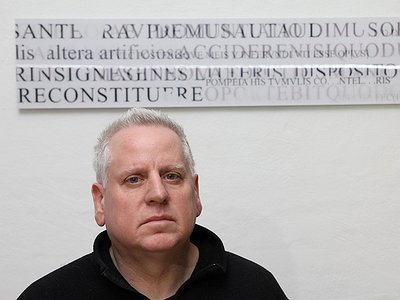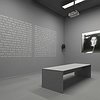Name: Arnold Dreyblatt
Occupation: Composer, media artist
Nationality: American
Recent release: Arnold Dreyblatt teams up with Oren Ambarchi, Konrad Sprenger and Joachim Schütz for Resolve, out August 18th 2023 via Drag City.
[Read our Oren Ambarchi interview]
If you enjoyed this Arnold Dreyblatt interview and would like to find out more about his work and current projects, visit his official website. He is also on Instagram, and Facebook.
Over the course of his career, Arnold Dreyblatt studied and collaborated with a wide range of artists, including Pauline Oliveros, Jim O'Rourke, and Werner Durand.
[Read our Pauline Oliveros interview]
[Read our Jim O'Rourke interview]
[Read our Werner Durand interview]
Where does the impulse to create something come from for you? What role do often-quoted sources of inspiration like dreams, other forms of art, personal relationships, politics etc play?
My music is very sound- and instrument- based. That is, I am searching for very specific sonorities which are based on specific instrumentations and a 20-tone tuning system based on the harmonic series.
Of course I am a product of many influences, especially from my early period in New York in the 70s when I began to develop my music. It was the era of early minimalism, exposure to the work of John Cage and then La Monte Young and Alvin Lucier, (both of whom I studied with), and friendships with Phill Niblock, Yoshi Wada and many others. But even earlier, I spent my high school years at the Fillmore East, and listened to alot of Rock Music and Jazz in the late 60s and early 70s.
I also began to listen and study many non-Western musics throughout the 70s and early 80s. All of that flows into who we are and what we make.
For you to get started, do there need to be concrete ideas – or what some have called a 'visualisation' of the finished work? What does the balance between planning and chance look like for you?
I think I start each piece with a kind of overall gestalt that includes a beat, a chord progression in my tuning and combinations of instruments and performance techniques. But this idea or concept is finally developed and fixed in rehearsal where the musicians bring their own histories to the final result.
In my solo work or pieces for other ensembles this process can take other trajectories where I am alone experimenting in my studio.
Is there a preparation phase for your process? Do you require your tools to be laid out in a particular way, for example, do you need to do 'research' or create 'early versions'?
I have always felt that for me, composition is not just about writing - in my process whatever is written down is only a bare-bones skeleton, to be realized in sound.
It always starts from sound production, perhaps a way of hitting a string, a particular rhythm in getting that going. Early on I became fixated on the vibration of strings on a monochord as a kind of "Ur-Instrument" where you can perceive both visually and sonically the principles of vibration and tuning. I need to have that starting sound, and then work with it actively.
But I've done a lot of research into acoustics in my early years, and that has continually informed my approach to this day.
Do you have certain rituals to get you into the right mindset for creating? What role do certain foods or stimulants like coffee, lighting, scents, exercise or reading poetry play?
It's really not a mysterious act in my case. If I am not continually creating, working on a project, etc., I am lost, I don't feel like myself.
But I am involved in many kinds of work in various mediums, I am also a visual artist, have worked in theater, I write, etc.
What do you start with? How difficult is that first line of text, the first note?
In terms of music, I think it all starts from the first note. Not a note on the page, but the first physical action of producing sound. There it all begins, and finally it all comes back to that.
What makes lyrics good in your opinion? What are your own ambitions and challenges in this regard?
I should first say that my work as a visual artist is strongly text-based. But ironically I have kept my interests somewhat separate - that is, my interest in text has to do with meaning, often using archival and historical documents.
That's very far from my interest in sound though there have been some projects in which text and sound co-exist. Probably one of the most important was my hypertext multi-media opera: Who's Who in Central & East Europe 1933 (Tzadik) from the early 90s in which I composed for the ensemble along spoken text, projected texts and images and singing by Shelley Hirsch.

A more recent work is The Resting State (2019), originally an installation, then a film and soon to be released as a sonic work for spoken text and sine waves. 
Also in my current solo work Transmission, spoken text recordings I made with the late Sam Ashley have been integrated into sections of the music.
Most of my work with text and music reflect a gradually shifting drone behind the text which allows one to shift attention from one to the other seamlessly.
To quote a question by the great Bruce Duffie: When you come up with a musical idea, have you created the idea or have you discovered the idea?
I think this is more of a semantic issue. We are conduits after all. One could say that it was all there, but then one of us "discovers" that flow. There's also the idea that there are ideas floating in certain historical periods.
In the case of my music, I think that I developed a fascination with certain types of sound and textures early on, I was hung up on overtones and drones and that has characterized my music from the beginning.
Someone once said that most artists are lucky to have one good idea, maybe two. Then they go with it. But there are also artists who move from genre to genre, where their persona is the continuing factor. Two sides of one coin!
From your experience, are there things you're doing differently than most or many other artists when it comes to writing music?
For me, the task of the "composer" and "musician" is to enable acoustic resonance - to set the strings or air in motion. In that sense, it is the instruments themselves (no matter how complex or simple) who are the stars of the show. We are only there to get that resonance out of them. Otherwise they are dormant.
It's the opposite of virtuosity - shaping the instrument to our will - the sound is already there - we only have to let it go.
Additionally, I came into music and sound from media arts - early video and experimental film, and perhaps my approach to musical structure has been very different from those who have passed through traditional music training. When I think of such pieces such as "Next Slide" from the 90s, I was shifting sonic images as one might edit a film.
Many writers have claimed that as soon as they enter into the process, certain aspects of the narrative are out of their hands. Do you like to keep strict control or is there a sense of following things where they lead you?
I do like to follow what happens and see where it might take me. But I am interested in fixing a basic structure during a rehearsal project so that it can be repeated in performance. The freedom is in having that structure but allowing some minimal elements to react to the live situation.
I have never been interested in improvisation for its own sake.
There are many descriptions of the creative state. How would you describe it for you personally? Is there an element of spirituality to what you do?
I think that the arts can allow the unsaid, the unresolved, to enter the conversation.
It's a question that is posed, without necessarily an answer. The unexpected happens, and one could call this many names.
Once a piece is finished, how important is it for you to let it lie and evaluate it later on? How much improvement and refinement do you personally allow until you're satisfied with a piece? What does this process look like in practise?
A lot of refinement takes place in rehearsals and performance. When I hear recordings of performances I often wish to make edits and other changes. But at some point, a state has been reached, and at that point one starts anew with another work.
The exception is my solo work Nodal Excitation, which is my first musical performance work. I have been performing it since 1979, and though it has changed and developed and morphed over the years, at the core it is the same.
I tried to stop it, but it came back to me. I like to think that it "informs" - I often begin concerts with this piece before the ensemble performs.
What's your take on the role and importance of production, including mixing and mastering for you personally? How involved do you get in this?
My music only exists in the mix and the nuances of this mixture are extremely important to me. The music has been amplified from the beginning in order to shine a microscope on the vibrating elements. There was even a phase where I mixed the band in live performance rather than perform in it because I felt I couldn't trust the sound technicians.
Fortunately the biographies of those who are behind the board have changed enormously - they are often musicians themselves.
After finishing a piece or album and releasing something into the world, there can be a sense of emptiness. Can you relate to this – and how do you return to the state of creativity after experiencing it?
Yes it's true. Something like giving birth, and a kind of postpartum afterwards.
But we all have to pick up and start again.
Creativity can reach many different corners of our lives. Do you personally feel as though writing a piece of music is inherently different from something like making a great cup of coffee? What do you express through music that you couldn't or wouldn't in more 'mundane' tasks?
This question is very hard to answer. For some, every action can be an aesthetic act. For another, it's the creation of something outside one's self which is the focus of being an artist.
I think its important to consider one's entire "life work" - and where you want to define the borders is up to others. I have been artistically creative for over 50 years, with many twists and turns. But there has been a line through all of that, sometimes bending, not always visible, branching out and coming back, but still there.






